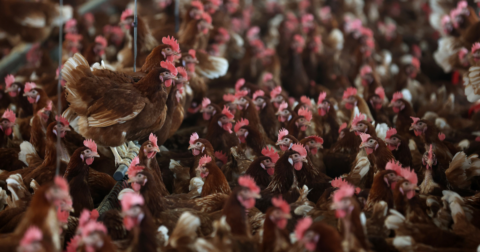Perspective
Critics Declared Veganism Dead in 2025. Here’s What Those Obituaries Are Missing.
Food•5 min read
Explainer
And will continue to do so.


Words by Seth Millstein
We’re in the fifth year of a worldwide avian flu outbreak, and there seems to be no end in sight. The standard containment measures haven’t been working, and as a result, egg prices are at record highs, and over a hundred million chickens are dead. But a closer look shows how egg farming helps facilitate the virus’s spread — and how the government’s attempts to stop the bird flu outbreak have fallen short.
“This is historic. We never had anything this big, geographically or species-wise,” Maurice Pitesky, an associate professor and expert in poultry disease modeling at the UC Davis School of Veterinary Medicine, tells Sentient. “This is way beyond [farmers’] skill set.”
The government has stepped in and attempted to end the outbreak through various means, but none have worked. And this is in part because egg farming itself, on a foundational level, is highly conducive to the spread of dangerous pathogens like avian flu.
As of 2022, the latest year for which data is available, there were a little over 168,000 farms in the U.S. that produced poultry products, in whole or in part.
Livestock chickens are generally divided into two categories: broilers, who are raised and slaughtered for meat, and layers, who are raised to lay eggs. At any given point, there are around 389 million layer hens at poultry farms across the U.S., and they produce about 109 billion eggs every year.
In the U.S. alone, farmers slaughter around 9.5 billion chickens every year, including both broilers and layers.
Avian influenza, also known as avian flu or bird flu, is nothing new. It was first discovered in the late 1800s, and there have been a number of high-profile outbreaks since then. In fact, a number of high-profile outbreaks happened in 2014.
But the most recent bird flu outbreak has proven much more resilient and deadly than those in the past. It began in 2020, and while previous outbreaks have died off after a few months to a year, this current one is now in its fifth year and showing no signs of letting up. It’s also been spreading to non-avian species, including pigs and cows, as well as people. Backyard chickens and small farms are also far from immune from the virus.
The current strain of avian flu is believed to have originated in wild birds, not animal farms. But there are a number of things about animal farms, and chicken farms specifically, that make them especially susceptible to spreading the disease.
To begin with, the living conditions on poultry farms are almost tailor-made to facilitate the spread of disease. This is especially the case when the chickens are confined in close spaces, as they are on factory farms, but it’s also just an intrinsic fact about chicken husbandry itself. Chickens are highly social creatures who interact regularly with one another, and disease spreads rapidly through flocks even when the animals have a healthy amount of space.
That said, practices common to factory farms make the situation much worse, and not solely because the chickens in them are typically crammed together in tight spaces. The poultry industry has selectively bred chickens in order to maximize egg output, but selective breeding leads to a low level of genetic diversity within flocks. This, in turn, might make the flocks more susceptible to diseases, according to a 2008 study.
The sheer size of factory farms is another exacerbating factor for avian flu: If one chicken gets the disease, everyone else in the flock is also at risk, and when the flock in question has tens of thousands of chickens in it, that’s a whole lot of potentially exposed birds. On smaller farms and backyard farms that follow different practices, the risk is still there. It’s just mostly owing to spread from wild birds rather than these other factors.
One reason this recent outbreak has worried epidemiologists so much is its ability to spread to non-bird species. This aspect, too, is potentially related to chicken farms: Dairy cows are sometimes fed “poultry litter” — a euphemistic name for the mixture of chicken manure, feed, feathers and other organic garbage from poultry farms — and it’s been speculated that this practice may be responsible for spreading the virus to dairy cows, who in turn have been spreading it to people, mostly farm workers.
The federal government authorizes chicken farmers to slaughter their entire flock if even one case of avian flu is detected, and farmers who do this are compensated by the USDA for their losses. These are called indemnity payments, and the USDA has doled out over $1 billion of them so far.
But although the government pays farmers to kill their flocks after detecting H5N1, it has not, until very recently, required farms to implement biosecurity measures in order to receive those payments. For the bulk of the outbreak, farms that experienced outbreaks were required to submit biosecurity plans, but the USDA did not engage its oversight powers to ensure that these plans were actually being implemented. And in December, a USDA report found that the bailouts were inadvertently incentivizing farms not to strengthen their biosecurity measures.
This may be why, according to the USDA, a total of 67 egg farms have been infected with H5N1 more than once, even after culling their flocks and receiving bailout money from the government.
It also may be why the USDA updated its biosecurity policies this year, and is now requiring H5N1-infected farms to pass a visual audit in order to receive any future indemnity payments.
Most of these biosecurity measures concern the structures and policies at the egg farms themselves. But Pitesky says that they should also account for what’s going on near the farms, given that wild waterfowl are one of the main ways the virus spreads to poultry farms in the first place.
“There’s this whole concept of what I call ‘outward facing biosecurity,’ and I don’t think we really do any of that at this point,” Pitesky says. “And that’s really focused on what’s going on within about a four kilometer diameter of your facility.”
The closest to what Pitesky is describing, at least on the governmental level, is the Biden administration’s Wildlife Biosecurity Assessments program, a pilot program in which the USDA sends staff to infected farms to survey the surrounding areas for potential security holes.
The Trump administration recently announced an expansion of this program, but crucially, it only involves a one-time survey of each farm. What’s really needed, according to Pitesky, is ongoing monitoring and surveillance of the surrounding areas, as that’s the only way to account for constantly changing environmental conditions in the wild.
“The thing that we all have to realize is that the farm doesn’t change location, but the habitat around the farm changes,” Pitesky says. “Until we really understand what’s going on outside the facility, we’re just going to be reactive. We’re going to see which places get affected, and then we’re going to respond. But then a year later, it’s going to be something 50 kilometers to the west or east that gets hit.”
According to the CDC, H5N1 has affected over 166 million birds in the U.S. since 2022. Needless to say, this has dramatically reduced the national egg supply, which in turn has caused egg prices to skyrocket — at least, according to the egg industry. While that’s been a very unwelcome development for consumers, many egg farmers have been enjoying record profits during the outbreak regardless, in part due to these higher prices.
“If you’re lucky enough to not have been hit by bird flu, then your costs haven’t changed very much, and the price of eggs is double,” Aaron Smith, Gordon Rausser Distinguished Chair and Professor of Agricultural and Resource Economics at the University of California, Berkeley, tells Sentient. “So you’re making some pretty big profits right there.”
However, some have also accused egg producers of price-gouging to take advantage of the bird flu outbreak, and a coalition of farmers has demanded that the FTC investigate this possibility.
It’s also been suggested that general inflation has played a role in the high egg prices we’re seeing now, but Smith believes this isn’t the case.
“The worst inflation was in 2022-2023,” Smith says. “Pretty much everything in the economy went up by 20-25 percent. Egg prices are, what, approximately double what they were, so it’s mostly the flu” [driving up prices].”
There’s one very cheap step the government hasn’t taken to try and stop the spread of bird flu: Advising people to eat fewer eggs. Americans tend to not be so fond of the idea of being told what to eat, but it is our enormous appetite for eggs that egg farms are as ubiquitous as they are, and without that level of consumption, bird flu would be a fraction of the problem it is now.
The uncomfortable truth is as long as animal agriculture exists on both an expansive and industrial scale, we’ll be dealing with zoonotic diseases and their fallout. In this case, that fallout is over 150 million dead chickens and an increasingly expensive breakfast.
Update: an earlier version of this story was first published February 4, 2022.